I was privileged to attend the All Party Parliamentary Group for Assistive Technology reception. This was held on 8 May 2025 in Westminster. It was an honour to share first some of my lived experiences about using AAC. Then second, some very top-line preliminary findings from my Master’s of Research dissertation.
My studies focus on ‘the extent policy supports the provision of powered AAC for children in England’. Several people have asked me for quotes from this speech, so please find it in full below.
Thank you. I was delighted to hear the Department of Education’s announcement for a digital revolution in schools. When the Education Secretary outlined her proposals to modernise education, from the way we train our teachers and how we use technology in classrooms, she was singing from my hymn sheet. What is now important is we must not leave behind any child, or young person, who would benefit from specialist assistive technology and augmentative and alternative communication, often called AAC for short.
Technology is a game changer, it levels the playing field. I am a case in point. I got my first AAC assessment at the age of 3, nearly 30 years ago, ready to begin school at 4, I also had a BBC computer that took up a whole table, at the back of my mainstream primary classroom. I know having assistive technology is not just about having a voice. It is also an alternate pencil to access the curriculum, demonstrate learning, and to fulfil your own potential. Specialist technology like the different types of equipment I’m using today, is not off the peg. Around 1 in every 2000 children benefit from powered AAC.”
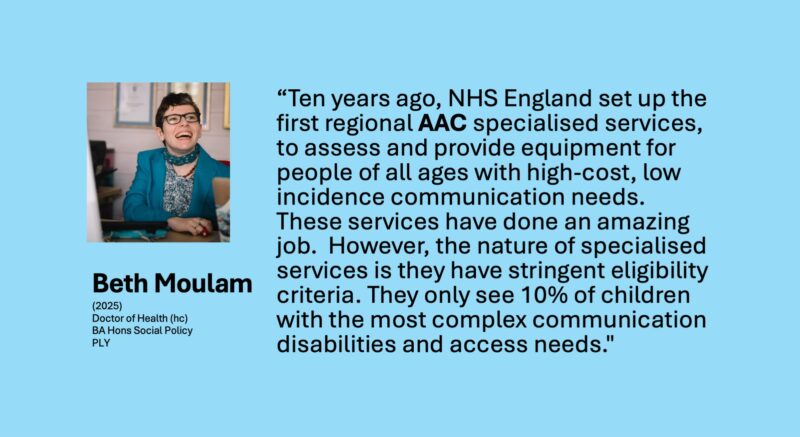
It was intended the remaining 90% of children and young people, those with autism, developmental language disorder, and other conditions, would be supported by local specialist AAC services. These were to be commissioned by the then clinical commissioning groups, or today’s integrated care boards. Some areas have these services, but many sadly still don’t. What this means is a postcode lottery for many children who would benefit from technology to access not just the curriculum, but also family and community life, and ultimately become economically active. As technology has changed, and often become more accessible, then research and practice have identified more children who will benefit from digital solutions. Tablets and iPads have revolutionised the world for us all, especially those who can access mainstream solutions.
My [Masters] research has been around the extent policy supports the provision of powered AAC in England for children. The preliminary findings indicate the intent of existing policy is to hear the individual child’s voice, placing them central to decision making. Sadly, policy implementation is often harder for many reasons. Today only some children get an AAC assessment, without a device these children continue to struggle to communicate.”
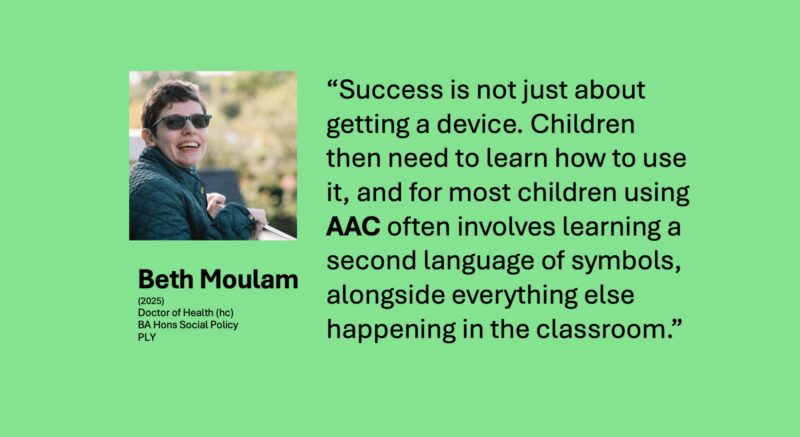
We can explain the current two-tier model of provision, or in some case non-provision, by many factors from the last decade. Whilst understanding the causes we now need to focus on the solutions. Local commissioners have a remit to provide AAC services that identify and assess need, then provide ongoing support for all AAC users. To make this happen there is a need for a well-trained children’s workforce to support a cradle to grave service, similar to the way the NHS commission services for those with hearing or vision impairments, and education have teachers for the deaf and visually impaired. Sadly, the special educational needs code of practice intent for joint working has not facilitated the intended health and education multidisciplinary teams, needed to make this happen. Yet we now know when AAC is provided early we significantly reduce the language gap between that child and their peers and provide better life outcomes.”
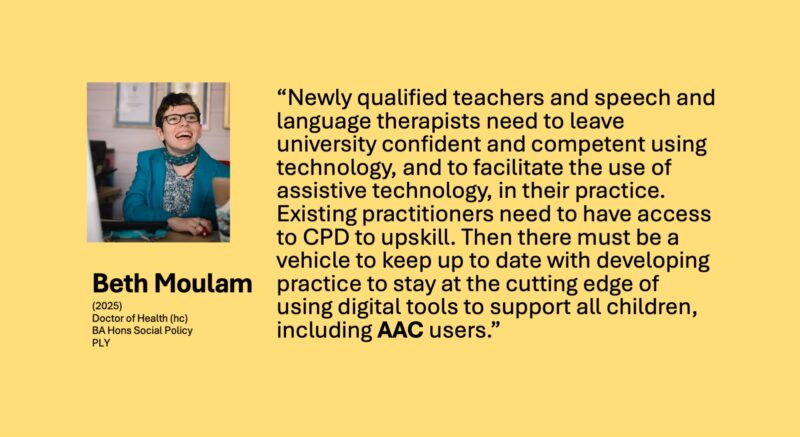
Ofsted need to be more involved in understanding the benefits of specialist assistive technology and AAC. We need a mindset that all children in special schools can be taught literacy, and will make progress. There is an imperative to monitor not just what happens in the classroom, but the impact made by speech and language professionals around the use of AAC. When current policies were written over 10 years ago the intent was right. Communication disability is a health need, and these children need multi-disciplinary professional teams to support their ongoing development. We now have evidence supporting the need to presume competence for every child and to expect them to fulfil their own communication potential.”
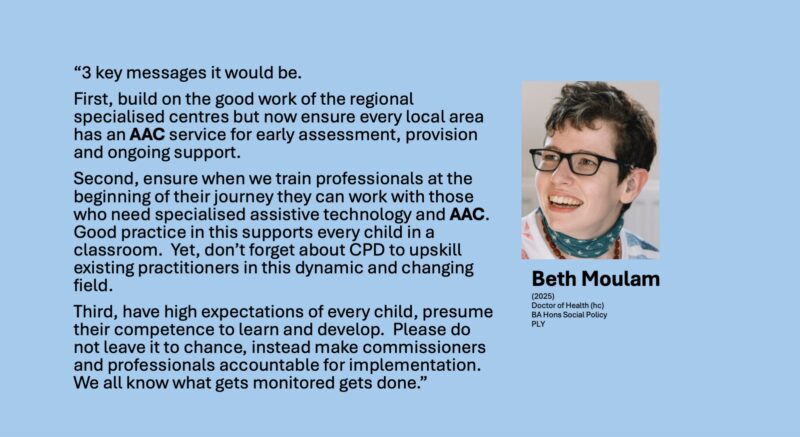
We are in a golden age; assistive technology is here to stay. We need to act now so we do not leave anyone behind. In the words of Emma Watson [2014], if not now, when? And if not us, then who will make this happen?”
Actually, for clarification, I know Emma Watson said at the United Nations 2014 He for She launch, “If not now, when? If not me, who?”. However, I wanted to emphasise to the All Party Parliamentary Group for Assistive Technology Reception attendees the need to act now. When it comes to ensuring children who need AAC get assessed and provided with resources, we all need to be on board so no one is left behind.
On the day there were fabulous presentations from Laura Brown, Robert McLaren and Prof Annalu Waller OBE.
Thank you to Policy Connect and to Communication Matters
My dissertation will be submitted by September 2025. Interested in booking me to come and share my full findings? Please use the contact form here

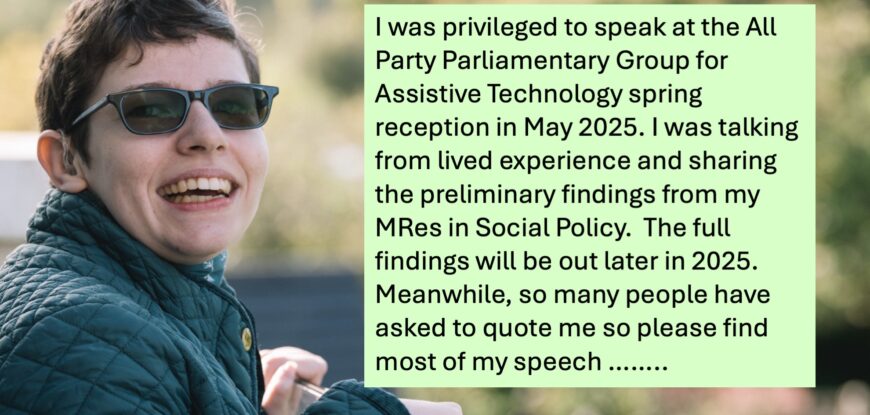
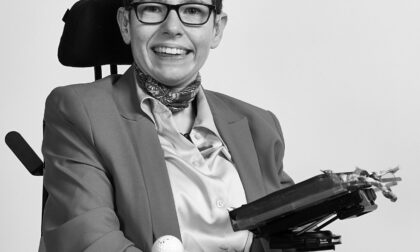
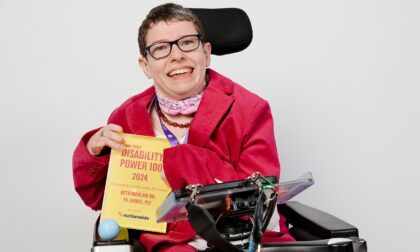

If you found this interesting or
helpful please feel free to share.